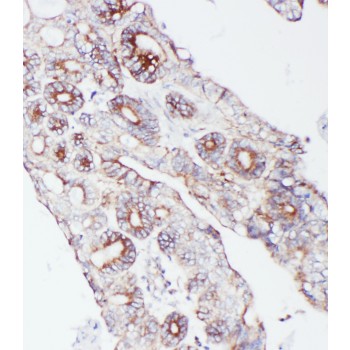More info
Overview
Long Name | Antibody Type | Antibody Isotype | Host | Species Reactivity | Validated Applications | Purification |
| proprotein convertase subtilisin/kexin type 9 | Polyclonal | IgG | Rabbit | Human | IHC-P, WB | Immunogen affinity purified. |
Immunogen | ||||||
| A synthetic peptide corresponding to a sequence at the C-terminus of human PCSK9(671-687aa AVTAVAICCRSRHLAQA). | ||||||
Properties
Form | Lyophilized |
Size | 100 µg/vial |
Contents | Antibody is lyophilized with 5 mg BSA, 0.9 mg NaCl, 0.2 mg Na2HPO4, 0.05 mg Thimerosal and 0.05 mg NaN3. *carrier free antibody available upon request. |
Concentration | Reconstitute with 0.2 mL sterile dH2O (500 µg/ml final concentration). |
Storage | At -20 °C for 12 months, as supplied. Store reconstituted antibody at 2-8 °C for one month. For long-term storage, aliquot and store at -20 °C. Avoid repeated freezing and thawing. |
Additional Information Regarding the Antigen
Gene | PCSK9 |
Protein | Proprotein convertase subtilisin/kexin type 9 |
Uniprot ID | Q8NBP7 |
Function | Crucial player in the regulation of plasma cholesterol homeostasis. Binds to low-density lipid receptor family members: low density lipoprotein receptor (LDLR), very low density lipoprotein receptor (VLDLR), apolipoprotein E receptor (LRP1/APOER) and apolipoprotein receptor 2 (LRP8/APOER2), and promotes their degradation in intracellular acidic compartments (PubMed:18039658). Acts via a non-proteolytic mechanism to enhance the degradation of the hepatic LDLR through a clathrin LDLRAP1/ARH-mediated pathway. May prevent the recycling of LDLR from endosomes to the cell surface or direct it to lysosomes for degradation. Can induce ubiquitination of LDLR leading to its subsequent degradation (PubMed:18799458, PubMed:17461796, PubMed:18197702, PubMed:22074827). Inhibits intracellular degradation of APOB via the autophagosome/lysosome pathway in a LDLR-independent manner. Involved in the disposal of non- acetylated intermediates of BACE1 in the early secretory pathway (PubMed:18660751). Inhibits epithelial Na(+) channel (ENaC)- mediated Na(+) absorption by reducing ENaC surface expression primarily by increasing its proteasomal degradation. Regulates neuronal apoptosis via modulation of LRP8/APOER2 levels and related anti-apoptotic signaling pathways. |
Tissue Specificity | Expressed in neuro-epithelioma, colon carcinoma, hepatic and pancreatic cell lines, and in Schwann cells. |
Sub-cellular localization | Cytoplasm. Secreted. Endosome. Lysosome. Cell surface. Endoplasmic reticulum. Golgi apparatus. Note: Autocatalytic cleavage is required to transport it from the endoplasmic reticulum to the Golgi apparatus and for the secretion of the mature protein. Localizes to the endoplasmic reticulum in the absence of LDLR and colocalizes to the cell surface and to the endosomes/lysosomes in the presence of LDLR. The sorting to the cell surface and endosomes is required in order to fully promote LDLR degradation. |
Sequence Similarities | Belongs to the peptidase S8 family. |
Aliases | Convertase subtilisin/kexin type 9 preproprotein antibody|FH3 antibody|HCHOLA3 antibody|Hypercholesterolemia autosomal dominant 3 antibody|LDLCQ1 antibody|NARC 1 antibody|NARC-1 antibody|NARC1 antibody|Neural apoptosis regulated convertase 1 antibody|Neural apoptosis-regulated convertase 1 antibody|PC 9 antibody|PC9 antibody|PCSK 9 antibody|PCSK9 antibody|PCSK9_HUMAN antibody|Proprotein convertase 9 antibody|Proprotein convertase PC9 antibody|Proprotein convertase subtilisin/kexin type 9 antibody|PSEC0052 antibody|Subtilisin/kexin like protease PC9 antibody|Subtilisin/kexin-like protease PC9 antibody |
Application Details
| Application | Concentration* | Species | Validated Using** |
| Western blot | 0.1-0.5μg/ml | Human | AssaySolutio's ECL kit |
| Immunohistochemistry(Paraffin-embedded Section) | 0.5-1μg/ml | Human | AssaySolutio's IHC/ICC Detection kit |
AssaySolution recommends Rabbit Chemiluminescent WB Detection Kit (AKIT001B) for Western blot, and Rabbit Peroxidase IHC/ICC Detection Kit (AKIT002B) for IHC(P). *Blocking peptide can be purchased at $65. Contact us for more information

Anti-PCSK9 antibody, ASA-B1490, Western blotting
All lanes: Anti PCSK9 (ASA-B1490) at 0.5ug/ml
Lane 1: A549 Whole Cell Lysate at 40ug
Lane 2: HELA Whole Cell Lysate at 40ug
Lane 3: U87 Whole Cell Lysate at 40ug
Lane 4: PANC Whole Cell Lysate at 40ug
Predicted bind size: 74KD
Observed bind size: 74KD
All lanes: Anti PCSK9 (ASA-B1490) at 0.5ug/ml
Lane 1: A549 Whole Cell Lysate at 40ug
Lane 2: HELA Whole Cell Lysate at 40ug
Lane 3: U87 Whole Cell Lysate at 40ug
Lane 4: PANC Whole Cell Lysate at 40ug
Predicted bind size: 74KD
Observed bind size: 74KD

Anti-PCSK9 antibody, ASA-B1490, IHC(P)
IHC(P): Human Intestinal Cancer Tissue
IHC(P): Human Intestinal Cancer Tissue



